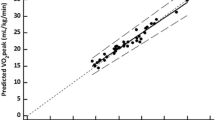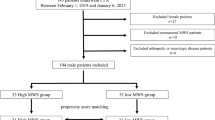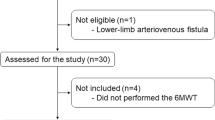Abstract
Background and objective
Low levels of cardiorespiratory fitness are associated with a high risk of cardiovascular disease (CVD) and all-cause mortality in women. The aim of this study was to determine the validity of a 500-m moderate treadmill-walking test for estimating peak oxygen uptake (VO2peak) in older women with CVD.
Methods
Fifty-three women with stable CVD (age 70.4 ± 8.2 years) underwent exercise testing during an outpatient cardiac rehabilitation/secondary prevention program. Each patient completed a maximal cardiopulmonary exercise test, and a moderate and self-paced (11–13/20 on the Borg scale) 500-m treadmill-walking test. Treadmill walk time, age, weight, height, and heart rate during the test were entered into prediction equations previously validated for VO2peak estimation in male patients.
Results
Measured and estimated VO2peak values were not different (20.8 ± 4.3 vs 21.3 ± 4.6 mL/kg/min, P = 0.12). The comparison between measured and estimated VO2peak values yielded a correlation of R = 0.92 (SEE = 1.3 mL/kg/min, P < 0.0001), with the slope and the intercept that coincided with the line of identity (Passing and Bablok analysis, P = 0.65). Residuals were normally distributed with a mean value of − 0.5 mL/kg/min. Examination of the Bland–Altman analysis does not show systematic or proportional error.
Conclusion
A moderate and self-regulated 500-m treadmill-walking test is a valid tool for VO2peak estimation in older women with CVD. These findings may have practical implications in the context of transitioning from clinically based programs to fitness facilities or self-guided exercise programs in older women with stable cardiovascular disease.


Similar content being viewed by others
References
Mozaffarian D, Benjamin EJ, Go AS et al (2016) Heart disease and stroke statistics-2016 update: a report from the American Heart Association. Circulation 133:e38–e360. https://doi.org/10.1161/CIR.0000000000000350
Gulati M (2017) Improving the cardiovascular health of women in the nation. Moving beyond the bikini boundaries. Circulation 135:495–498
Guidelines for Cardiac Rehabilitation and Secondary Prevention Programs (2013) 5th edn. American Association of Cardiovascular and Pulmonary Rehabilitation. Human Kinetics, Champaign ISBN-13:9781450459631
McSweeney JC, Rosenfeld AG, Abel WM et al (2016) Preventing and experiencing ischemic heart disease as a woman: state of the science: a Scientific Statement From the American Heart Association. Circulation 133:1302–1331. https://doi.org/10.1161/CIR.0000000000000381
Ross R, Blair SN, Arena R et al (2016) Importance of assessing cardiorespiratory fitness in clinical practice: a case for fitness as a clinical vital sign. A Scientific Statement from the American Heart Association. Circulation 134:e653–e699
Albright C, Thompson DL (2006 Apr) The effectiveness of walking in preventing cardiovascular disease in women: a review of the current literature. J Womens Health (Larchmt) 15(3):271–280
Simonsick EM, Montgomery PS, Newman AB et al (2001) Measuring fitness in healthy older adults: the Health ABC Long Distance Corridor Walk. J Am Geriatr Soc 49:1544–1548
Rolland YM, Cesari M, Miller MF et al (2004) Reliability of the 400-m usual-pace walk test as an assessment of mobility limitation in older adults. J Am Geriatr Soc 52:972–976
De Souza e Silva CG, Franklin BA, Forman DE et al (2016) Influence of age in estimating maximal oxygen uptake. J Geriatr Cardiol 13:126–131
Simonsick EM, Newman AB, Visser M et al (2008) Mobility limitation in self-described well-functioning older adults: importance of endurance walk testing. J Gerontol Med Sci 63A,8:841–847
Sayers SP, Guralnik JM, Newman AB et al (2006) Concordance and discordance between two measures of lower extremity function: 400 meter self-paced walk and SPPB. Aging Clin Exp Res 18:100–106
American Thoracic Society (2003) ATS/ACCP statement on cardiopulmonary exercise testing. Am J Respir Crit Care Med 167:211–277
Simonsick EM, Fan E, Fleg JL (2006) Estimating cardiorespiratory fitness in well-functioning older adults: treadmill validation of the long distance corridor walk. J Am Geriatr Soc 54:127–132
Pober DM, Freedson PS, Kline GM et al (2002) Development and validation of a one-mile treadmill walk test to predict peak oxygen uptake in healthy adults ages 40 to 79 years. Can J Appl Physiol 27:575–588
Clarke J, De Lannoy L, Ross R (2017) Comparison of measures of maximal and submaximal fitness in response to exercise. Med Sci Sports Exerc 49:711–716
Best JR, Liu-Ambrose T, Metti AL et al (2017) Longitudinal associations between walking speed and amount of self-reported time spent walking over a 9-year period in older women and men. J Gerontol Med Sci. https://doi.org/10.1093/gerona/glx129
Chiaranda G, Myers J, Mazzoni G et al (2012) Peak oxygen uptake prediction from a moderate, perceptually regulated, 1-km treadmill walk in male cardiac patients. J Cardiopulm Rehabil Prev 32:262–269
Grazzi G, Chiaranda G, Myers J et al (2017) Outdoor reproducibility of a 1-km treadmill-walking test to predict peak oxygen consumption in cardiac outpatients. J Cardiopulm Rehab Prev https://doi.org/10.1097/HCR.0000000000000266
Chiaranda G, Bernardi E, Codecà L et al (2013) Treadmill walking speed and survival prediction in men with cardiovascular disease: a 10-year follow-up study. BMJ Open 3(10):e003446. https://doi.org/10.1136/bmjopen-2013-003446
Grazzi G, Myers J, Bernardi E et al (2014) Association between VO2peak estimated by a 1-km treadmill walk and mortality. A 10-year follow-up study in patients with cardiovascular disease. Int J Cardiol 173:248–252
Grazzi G, Mazzoni G, Myers J et al (2017) Determining the best percent-predicted equation for estimated VO2peak by a 1-km moderate perceptually-regulated treadmill walk to predict mortality in outpatients with cardiovascular disease. J Sci Med Sport. https://doi.org/10.1016/j.jsams.2017.06.003
Grazzi G, Mazzoni G, Myers J et al (2017) A moderate 1-km treadmill walk predicts mortality in men with mid-range left ventricular dysfunction. Eur J Prev Cardiol. https://doi.org/10.1177/2047487317722434
Grazzi G, Mazzoni G, Myers J et al (2016) Improved walking speed is associated with lower hospitalisation rates in patients in an exercise-based secondary prevention programme. Heart 102:1902–1908
Fleg JL, Piňa IL, Balady GJ et al (2000) Assessment of functional capacity in clinical and research applications. AHA Sci Advis Circ 102:1591–1597
Kline GM, Porcari JP, Hintermeister R et al (1987) Estimation of VO2max from a one-mile track walk, gender, age, body weight. Med Sci Sports Exerc 19:253–259
Arena R, Sietsema KE (2011) Cardiopulmonary exercise testing in the clinical evaluation of patients with heart and lung disease. Circulation 123:668–680
Widrick J, Ward A, Ebbeling C et al (1992) Treadmill validation of an over-ground walking test to predict peak oxygen consumption. Eur J Appl Physiol 64:304–308
Vehrs PR, Georgea JA, Fellinghamb GW et al (2007) submaximal treadmill exercise test to predict VO2max in fit adults. Meas Phys Educ Exerc Sci 11:61–72
Loe H, Nes BM, Wisloff U (2016) Predicting VO2peak from submaximal and peak exercise models: the Hunt 3 fitness study, Norway. PLoS One 11(1):e0144873. https://doi.org/10.1371/journal.pone.0144873
Laskin JJ, Bundy S, Marron H et al (2007) Using a treadmill for the 6-minute walk test. J Cardiopulm Rehab Prev 27:407–410
Belza B, Walwick J, Shiu-Thornton S et al (2004) Older adult perspectives on physical activity and exercise: voices from multiple cultures. Prev Chronic Dis 1:1–12
Burton E, Lewin G, Boldy D (2015) Physical activity preferences of older home care clients. Int J Older People Nurs 10:170–178
Author information
Authors and Affiliations
Corresponding author
Ethics declarations
Conflict of interest
The authors declare they have no conflict of interest.
Ethical approval
The Human Studies Committee of the University of Ferrara, number 22-13, approved the study.
Informed consent
Informed consent was obtained from all the participants included in the study.
Rights and permissions
About this article
Cite this article
Mazzoni, G., Chiaranda, G., Myers, J. et al. Peak oxygen uptake estimation from a moderate 500-m treadmill walk in older women with cardiovascular disease. Sport Sci Health 14, 655–661 (2018). https://doi.org/10.1007/s11332-018-0483-9
Received:
Accepted:
Published:
Issue Date:
DOI: https://doi.org/10.1007/s11332-018-0483-9




